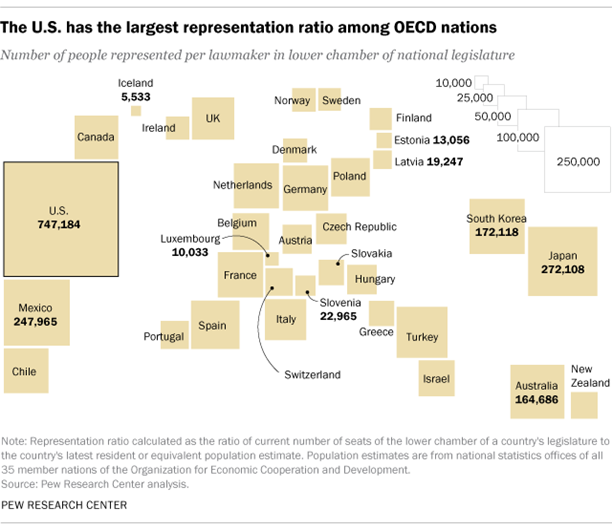Replace career politicians with citizen legislators.
Our nation’s founders intended that the number of Representatives forever increase in direct proportion to the total population.
Our nation’s founders intended that the number of Representatives forever increase in direct proportion to the total population.
Instead, for over a century, Congress has restricted our representation in the House to an oligarchy of 435, which is far too few to faithfully represent over 330 million Americans!
Restore the People’s House
Thomas Jefferson observed that “When the people fear their government, there is tyranny; when the government fears the people, there is liberty.” Recent history demonstrates the threats posed to our liberties when our government, and in particular our elected representatives, no longer fear the people. In fact, most of them don’t even respect us.
As explained in this web pamphlet, increasing the number of federal representatives – by replacing 435 imperial-sized congressional districts with several thousand community-sized ones – will restore political power to the people by ending incumbent domination of reelections, diminishing lobbyists’ influence, overcoming political-party control of our government, maximizing individual liberty, and reducing the size of government.
This is not a new idea: Historical documents reveal that our nation’s founders intended that the number of Representatives in the U.S. House be increased every ten years to keep pace with the total population. For example, Federalist 58 states that one of the “unequivocal objects” of the population census is “to augment the number of representatives … under the sole limitation that the whole number [of Representatives] shall not exceed one for every thirty thousand inhabitants.”
Most significantly, the intended purpose of “Article the first” – the very first amendment proposed in the original Bill of Rights – was to limit the number of people represented by each Representative to 50,000. This would ensure that the number of Representatives forever increases along with the population, thereby maintaining the viability of our representative democracy as the nation grew. Unfortunately, and as explained in this website, a defective version of this proposal, rather than the intended version, was submitted to the states. As a result, it was never ratified, and the solution intended by the founders subsequently disappeared into America’s memory hole.
However, reflecting the founders’ intent, from 1790 to 1910 Congress regularly increased the number of Representatives in order to reflect the growth in our nation’s population. Congress last increased the number of Representatives to 435 after the 1910 Census when the total population reached 91 million. Over a century later, we still have only 435 federal Representatives even though the total population has more than tripled! Consequently, each congressional district currently contains, on average, over 760,000 people! Not only are such massive districts contrary to the founders’ vision but, as noted in a recent report from the American Academy of Arts & Sciences:
“The chamber’s lack of growth over the last ninety years has had serious and harmful consequences for both representatives and the voting public. One result has been that the connection between constituents and their congresspeople has attenuated, leading to worse representation and bolstering the feeling among voters that their voice does not matter.”1The American Academy of Arts & Sciences: The Case for Enlarging the House of Representatives, an “Our Common Purpose” report (Dec 2021)
In order for the citizens of America to take back our republic, we first must regain control of the House of Representatives. The only way to achieve this is by significantly increasing the number of congressional districts.
“A body of men, holding themselves accountable to nobody, ought not to be trusted by anybody.” — Thomas Paine
“[The House of Representatives] should have an immediate dependence on, and an intimate sympathy with, the people.” — James Madison (Federalist 52)
“We the people are the rightful masters of both Congress and the Courts, not to overthrow the Constitution but to overthrow the men who would pervert the Constitution.” — Abraham Lincoln
“The career politicians in Washington had transformed a government ‘for the people’ into a government for themselves and for special interests.” — Tom Coburn
“Washington DC is corporate-occupied territory.” — Ralph Nader
Representational Enlargement: An Overview
In 1789, the first Congress of the United States proposed a list of twelve constitutional amendments which later became known as our Bill of Rights. The very first amendment on this list, Article the first, has never been ratified. As it turns out, there are two versions of this proposal: The one that was intended by Congress and, quite mysteriously, an embarrassingly defective version that was inexplicably sent to the states for ratification. Though the story of Article the first is quite fascinating, the larger story is about the many adverse consequences that have resulted from the failure to ratify this intended solution.
One of those adverse consequences is that our House of Representatives, which the founders expected to always be the People’s House, was long ago taken over by a corrupt political ruling class that largely serves their masters: Special Interests such as mega corporations, foreign interests, labor unions, Wall Street financiers, and tech tycoons. Consequently, except for a few virtuous men and women, the Representatives in the U.S. House are no longer truly answerable to their constituents. As explained throughout this website, passage of Article the first (in its intended form) would fix this problem.
The purpose of Article the first was to fix that part of the Constitution that James Madison called “defective”. The defect? Though the Constitution established the maximum House size at one Representative for every 30,000 people, it did not specify a corresponding minimum size. So glaring was this deficiency that, after the constitution was submitted to the states for ratification, this provision generated more condemnation than any other! James Madison proposed an amendment to eliminate this defect which, after extensive debate, evolved to become the very first amendment passed by the first Congress: Article the first. This proposal was intended to establish a minimum House size of one Representative per 50,000 people to ensure that the representation in the House would always be truly representative of the people.
Stated differently, our Constitution requires that the average district (or constituency) size per Representative should be no less than 30,000 people (hence our name Thirty-Thousand.org). It is that minimum district size that determines, to this day, the maximum allowable size of the House of Representatives. For example, relative to the 2020 population census, the maximum number of Representatives currently allowed is 11,036.2Population of 331,108,434 ÷ 30,000 = 11,036 (rounded down).
However, the failure of the Constitution to establish a corresponding maximum district size was considered such a serious deficiency that the first amendment passed by Congress was intended to correct this omission by establishing a maximum average district population size of 50,000. Had this been ratified, the minimum size of the House would currently be 6,623 Representatives.3Population of 331,108,434 ÷ 50,000 = 6,623 (rounded up). In this case, Congress would have to choose House size somewhere between 6,623 and 11,036 Representatives beginning with the 118th Congress, which would result in an average congressional district size (nationwide) between 30,000 and 50,000.
From today’s perspective, it might be assumed that the founders could not have possibly imagined, back in 1789, that the House would eventually become so large under their proposal. However, they actually had a very sophisticated understanding of immigration and population growth. That is why Federalist 55 contemplated an eventual House size of six to seven hundred, and even six to seven thousand! And because the British House of Commons then had approximately 558 members, it was easy for the founders to contemplate an ever-growing and very populous legislature.
Despite that, and because the intended version of Article the first was not proposed to the states, today Congress allows us only 435 Representatives in the “people’s house”, the same number that was first authorized back in 1913! So, as shown in the chart below, while Congress has restricted the total number of Representatives ever since 1913, the nation’s total population has grown 2½ times!
But why do we have so few Representatives, and how did the size of the House get fixed at 435? That is explained here. The point is, our congressional districts are vastly larger than what was intended by the founders. Consequently, as shown throughout this website, there are too few Representatives to ensure a sustainable and robust republic.
 So how big are our congressional districts today? As a result of the 2020 population census, their average population size is currently 760,000, which is 15 times larger than the maximum size of 50,000 proposed by the first congress! As a result, the United States has the largest average constituency size of any OECD country, as indicated in the adjacent graphic from Pew Research.4Pew Research: The U.S. has the largest representation ratio among OECD nations (May 29, 2018)
So how big are our congressional districts today? As a result of the 2020 population census, their average population size is currently 760,000, which is 15 times larger than the maximum size of 50,000 proposed by the first congress! As a result, the United States has the largest average constituency size of any OECD country, as indicated in the adjacent graphic from Pew Research.4Pew Research: The U.S. has the largest representation ratio among OECD nations (May 29, 2018)
Moreover, because of our grossly undersized House, the population sizes of our congressional districts vary wildly from state to state, ranging from 542,704 to 990,837. As a result, the citizens living in the smaller districts have more political weight than those living in the larger ones. This egregious violation of one-person-one-vote equality could easily be eliminated by enlarging our representation.
As explained in this website, our nation’s most vexing problems can be attributed to having a national legislature that is far too small relative to the total population, and therefore congressional districts that are vastly larger than the maximum size that the founders envisioned for our republic to endure. The problems resulting from this include financial corruption of the legislators, lavish incumbency advantages, gerrymandering, a political duopoly, voter inequality, and alarmingly high federal spending & debt. The solution is simple: Significantly reduce the maximum population size of congressional districts by enlarging the House, which can be done at any time without a constitutional amendment.
Reducing the average congressional district size to 50,000 would increase the number of Representatives to approximately 6,600. The good news is that the cost of this additional representation will be more than offset by the reduction in federal spending that results from having a truly representative body.
People naturally wonder how so many Representatives will fit into one building? The answer: They don’t. As Winston Churchill said, “We shape our buildings, and afterwards our buildings shape us.” Our government need not be shaped by its buildings. It is no longer necessary, or even advantageous, to require all federal Representatives to live and work in a single distant location.
Consider how the world looked when the Constitution was drafted in 1787. Mail delivery was slow prior to the establishment of the federal post office. New technologies such as steam powered rail travel and electric telegraphy were decades away from even being conceived. Consequently, when the Constitution was proposed, people had to assemble at one location in order to actually communicate and collaborate. And the only way to do that was to travel over great distances on foot or by horse.
It is no longer necessary, or even advantageous, to require that all Representatives convene at a single location. Nor is it explicitly required by the Constitution for the purpose of debating and voting on legislation. In fact, anyone who has been to the House chamber (or watched CSPAN) knows that the Representatives rarely “convene” as a body anymore except for ceremonial events. The notion of a true assembly of the House, with debate and deliberation, was largely abandoned generations ago.
Today, when votes are taken, the Representatives are usually pulled in just long enough to cast their vote before returning to their other activities (primarily committee work, campaigning, and fundraising). Virtually all of the work of Congress is performed in its various committees, a practice that will continue regardless of how large the House becomes. However, in a House with several thousand Representatives, several hundred may travel to DC to work in committees. Therefore, the remaining Representatives will spend most of their time in their home districts – participating virtually while living among their constituents – rather than being safely ensconced in the lobbyists’ stronghold of Washington D.C.
This is possible because modern technology makes other means available for virtually assembling and voting on bills. With a greatly enlarged House, most Representatives will work out of their home districts and be expected to devote their time to evaluating proposed legislation and regularly meeting with their constituents in person. In this capacity, the Representatives will be able to function as true citizen legislators, focusing on properly representing their constituents while protecting them from the federal government!
Just as importantly, consider the tremendous civic value of having the Representatives living among the citizenry, proactively educating us about pending legislation and other federal matters that may affect us. As a consequence of this, imagine how much more involved the average citizen would become in the oversight of our federal government! This would enable us to realize the vision of a truly representative House as described in “Federalist 49”:
The members of the legislative department … are numerous. They are distributed and dwell among the people at large. Their connections of blood, of friendship, and of acquaintance embrace a great proportion of the most influential part of the society. The nature of their public trust implies a personal influence among the people, and that they are more immediately the confidential guardians of the rights and liberties of the people.
That vision put forth by our Founders is in stark contrast to the alienated relationship we currently have with our Representatives. Though it is reasonable to expect that we should be able to personally communicate with our Representative regarding important constituent concerns, we have come to accept that such a privilege is generally reserved for the few who are personal friends of, or major contributors to, the Representative. In fact, our Representatives are barely known in the communities they are supposedly representing. Instead, Washington D.C. becomes their home, and their actual constituents are the lobbyists who work there.
Though Congress could enlarge the number of representatives at any time, it is exceedingly unlikely that the Representatives would voluntarily subdivide their powerful fiefdoms to the extent necessary to return political control to the people. This very problem was anticipated during the states’ ratification conventions in 1787 and 1788. For example, Melancton Smith, a member of the New York’s ratification convention, observed that:
“To me it appears clear, that the relative weight of influence of the different states will be the same, with the number of representatives at sixty-five as at six hundred, and that of the individual members greater; for each member’s share of power will decrease as the number of the House of Representatives increases. If, therefore, this maxim be true, that men are unwilling to relinquish powers which they once possess, we are not to expect the House of Representatives will be inclined to enlarge the numbers. The same motive will operate to influence the President and Senate to oppose the increase of the number of representatives; for, in proportion as the House of Representatives is augmented, they will feel their own power diminished. It is, therefore, of the highest importance that a suitable number of representatives should be established by the Constitution.”
Recognizing the adverse consequences of this “defect” in the Constitution, many of the states’ ratification conventions proposed constitutional amendments to establish a minimum House size. In the House of Representatives on June 8, 1789, James Madison offered a list of amendments to the Constitution which he had drawn from the numerous amendments proposed by the states’ conventions. The second proposal on his list was to fix that part of the Constitution which he himself had thought defective: The absence of a minimum House size requirement.
Madison’s proposal evolved (as it was subsequently debated in the House) until it took the form passed by two-thirds of the House on August 21, 1879. That proposal established a maximum district size of 50,000. A month later, two-thirds of the Senate agreed to the House’s proposal, making it the very first constitutional amendment passed by Congress. However, in the waning hours of the first congress, an alternate version was created which, though it appeared to be identical to the intended version, its effect would be virtually inconsequential. As a result, this would-be first amendment has been all but lost to history. This loss put our nation squarely on a path towards oligarchy, if not tyranny.
A New Revolution
The gradual transformation from community-sized congressional districts to massively sized ones has effectively nullified our representative democracy by shifting political power away from the citizenry to a collection of powerful Special Interests. The only way to restore control of the House of Representatives to the people is by increasing the number of Representatives in order to significantly reduce the congressional district sizes.
If faced with enough pressure from the public, perhaps Congress would deign to grant us a few additional Representatives, but the effects of that would be insignificant. Therefore, it will be necessary to compel Congress to increase the number of Representatives to the extent necessary, and to continue to adjust the total number every ten years in order to maintain proportionality with the total population. Unfortunately, the only way to compel this would be with a constitutional amendment. Ideally, such an amendment would be identical to that proposed by the House in August of 1789. Establishing a maximum congressional district size which is somewhere between 30,000 and 50,000 people would protect our individual liberties by ensuring that the government is truly subject to the consent of the governed. Until then, we the people will continue to suffer as the subjects of the federal government, rather than thrive as its masters.
Thomas Jefferson observed that: “Every generation needs a new revolution.” Now is the time for a political revolution to restore representative democracy in America! If we, the citizens of this great nation, fail to reassert control over our House of Representatives, then we could be the last generation to live under some semblance of freedom and liberty. America can be kept strong and vibrant only if our federal legislature is as dynamic, industrious and frugal as the American people. The revolution that every generation needs should be waged continuously, and constitutionally, within the chambers of our Congress. If we permit a stagnant and corrupt Congress to continue, then we will become known as the indolent generation that allowed the light of liberty to be extinguished. Only through representational enlargement can we evade this dreadful fate and reinvigorate the American exceptionalism that has blessed our great nation.
© Thirty-Thousand.org [Article Updated 02/01/22]
Related Articles:
The American Academy of Arts & Sciences: The Case for Enlarging the House of Representatives, an “Our Common Purpose” report (Dec 2021)
FairVote.org: The People’s House?
DownsizingGovernment.org: Special Interest Spending.
Statchatva.org: U.S. House districts are colossal. What’s the right size?
CenterForPolitics.org: It’s Time to Increase the Size of the House.
| ◄ Home Page | Section Two ► |
Explore More Topics:
- 1The American Academy of Arts & Sciences: The Case for Enlarging the House of Representatives, an “Our Common Purpose” report (Dec 2021)
- 2Population of 331,108,434 ÷ 30,000 = 11,036 (rounded down).
- 3Population of 331,108,434 ÷ 50,000 = 6,623 (rounded up).
- 4Pew Research: The U.S. has the largest representation ratio among OECD nations (May 29, 2018)





